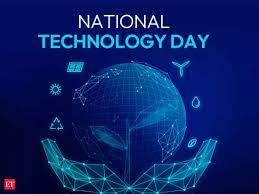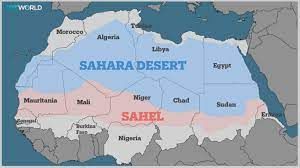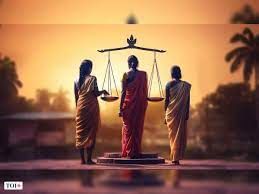UPSC Daily Current Affairs- 11th May 2023 | Current Affairs & Hindu Analysis: Daily, Weekly & Monthly PDF Download
GS-I
Sahel Region
Why in News?
The ongoing fighting in Sudan is forcing thousands to flee. The humanitarian emergency is spreading, creating a dangerous security situation in the Sahel region.
About:
- The Sahel is the ecoclimatic and biogeographic realm of transition in Africa between the Sahara to the north and the Sudanian savanna to the south.
- Having a semi-arid climate, it stretches across the south-central latitudes of Northern Africa between the Atlantic Ocean and the Red Sea.
- The Sahel part of Africa includes from west to east parts of northern Senegal, southern Mauritania, central Mali, northern Burkina Faso, the extreme south of Algeria, Niger, the extreme north of Nigeria, the extreme north of Cameroon and Central African Republic, central Chad, central and southern Sudan, the extreme north of South Sudan, Eritrea, and the extreme north of Ethiopia.
Source: Indian Express
Assam to Ban Polygamy
Why in News?
The Assam government will soon move to ban the practice of polygamy through “legislative action”.
More about the News
- Constituting “expert committee”:
- Assam Chief Minister recently said that an “expert committee” would be formed to examine whether the state legislature was empowered to prohibit polygamy.
- This committee, comprising legal experts and scholars, would examine the provisions of the Muslim Personal Law (Shariat) Act, 1937 read with Article 25 of the Constitution of India.
- Significance:
- Recently, the authorities found that many aged men got “married multiple times”, and often to minor girls.
- Therefore crackdown against child marriage is not the only solution, banning polygamy is also important.
More about the Polygamy
- About:
- Polygamy is defined as “the act or custom of maintaining more than one spouse at the same time”.
- Polygamy under Hindu Law:
- The Hindu Marriage Act, which came into effect on May 18, 1955, made it clear that Hindu polygamy would be abolished and criminalised.
- Monogamy was the sole option available to Hindus.
- The Hindu Marriage Act, 1955 states that polygamous marriages are void.
- It was made explicit that a Hindu spouse may not marry again until the first one is terminated, either through a divorce or the death of one of the spouses.
- Because Buddhists, Jains, and Sikhs are all considered Hindus and do not have their own laws, the provisions in the Hindu Marriage Act apply to these three religious denominations as well.
- The Hindu Marriage Act, which came into effect on May 18, 1955, made it clear that Hindu polygamy would be abolished and criminalised.
- Polygamy under the Muslim personal law:
- Crucially, while the Hindu personal law outlaws bigamy and polygamy, the Muslim personal law does not.
- The clauses under the ‘Muslim Personal Law Application Act (Shariat) of 1937, as construed by the All India Muslim Personal Law Board, apply to Muslims in India.
- A Muslim man can marry and maintain four women or spouses at the same time, according to Muslim personal law.
- Under Muslim personal law, such a relationship is recognised and legal.
- While a Muslim man can have four wives at the same time, however, the same is not applicable to a Muslim woman.
- A Muslim woman is not allowed to marry more than one individual.
- Global practice:
- Polygamy is permissible and legal exclusively for Muslims in nations such as India, Singapore, as well as Malaysia.
- Polygamy is still recognised and practiced in nations such as Algeria, Egypt, and Cameroon.
Issues & criticisms
- In conflict with constitutional values:
- Article 14 states that the state shall not refuse any individual under India’s territory equal treatment under the law and equal protection under the law. The state is prohibited from discriminating against any person solely based on faith, ethnicity, gender, religion, or birthplace, according to Article 15(1) of the Indian Constitution.
- Only because polygamy has already been embraced among the Islamic culture since the ancient period and has been adjusted as a topic of personal laws.
- Discriminatory in nature:
- According to academicians and some other knowledgeable people, permitting polygamy in one faith while condemning others is discriminatory, and this prejudice must be addressed by the law.
- Barbarous consequences:
- As a man cannot please all of his women emotionally or economically, it creates a purely barbarous consequence in a poygamous relationship.
- When the male partner dies, polygamy causes property disputes.
- Impact on children:
- Polygamy has an impact not only on the married couple but also on the offspring who are the result of such a relationship.
- This troubling issue causes trauma in youngsters, which has an impact on their education and interpersonal attitudes towards life.
- Gender discrimination:
- Polygamy regulations vary depending on a person’s gender within a single faith. Governments, on the other hand, have failed to consider the situation of women, particularly those who embrace Islam.
- Not a religious duty:
- Polygamy is not at all a preferred lifestyle choice & comes with several drawbacks. It is not at all a religious duty or religious conduct, as the court system has often acknowledged.
Way Ahead
- In patriarchal societies, religious laws have often been lopsided, favouring men.
- Laws such as polygamy, triple talaq, and nikah halala are not only archaic, but they are also debilitating for Muslim women.
- The legality of such laws needs to be challenged and subsequently discarded.
Source: Indian Express
GS-II
UN Security Council Reforms
Why in News?
China has maintained its stance on the UN Security Council reforms, saying there should be more representation for developing countries, but avoided a direct response to India and other countries’ call for its expansion and their inclusion.
About United Nations Security Council:
- The UNSC was established by the UN Charter in 1945.
- It is one of the 6 principal organs of the United Nations.
- UNSC has 15 members: 5 permanent members (P5) and 10 non-permanent members elected for 2-year terms.
- The 5 permanent members are: United States, Russian Federation, France, China and the United Kingdom.
- India has served seven times in the UNSC as a non-permanent member and in January 2021, India entered the UNSC for the eighth time.
UNSC elections:
- Each year the General Assembly elects five non-permanent members (out of 10 in total) for a two-year term.
- The 10 non-permanent seats are distributed on a regional basis as follows:
- Five for African and Asian States.
- One for the Eastern European States.
- Two for the Latin American and Caribbean States;
- Two for Western European and other States
- To be elected to the Council, candidate countries need a two-thirds majority of ballots of the Member States that are present and voting in the Assembly.
- The UNSC elections were traditionally held in the General Assembly hall with each of the 193 member states casting its vote in a secret ballot.
Need:
Changing world order:
- In the 77-year-old history of the UN, the composition of the Security Council has been altered only once.
- e., In 1963 when the General Assembly decided to expand the Council from 11 to 15 members, with the addition of four non-permanent seats.
- Since then, the world has changed. The geopolitical relations in the world have altered, the economic responsibilities in the world in countries have also changed.
Equitable World Order:
- There is a need for a more equitable world in order to uphold the principles of democracy at the global level.
- Developing countries like the African countries, need to be made stakeholders in the multilateral institutions and involved in the decision-making process.
Mitigation of New Threats:
- With rising protectionism, increased incidents of terrorism and the threat of climate change, the multilateral system must become more resilient and responsive.
Issues with regard to UNSC:
Lack of Adequate Representation:
- The UN Security Council is less effective because it is less representative, the most pertinent absence being that of Africa, a continent of 54 countries.
- Current global issues are complex, and interconnected.
- Lack of representation of geopolitical and geo-economically important countries is leaving out a large segment of global opinion to have a voice in the highest security summit.
Misuse of Veto Power:
- Veto power has been always criticized by many experts as well as by most States calling it a” self-chosen club of the privileged” and non-democratic and not allowing the Council to make necessary decisions whenever it displeases any one of the P-5.
- It is also not appropriate for the current global security environment to be guided by elite decision-making structures.
Geopolitical Rivalry within P5:
- The geopolitical rivalry among the permanent members has prevented the UNSC from coming up with effective mechanisms to deal with global issues.
- Taking the current world order as an example, the P5 members: United States, Russia, and China are three poles on the periphery of the globe having several geopolitical issues revolving around them (Taiwan Issue and Russia-Ukraine War).
Threat to State’s Sovereignty:
- As the principal organ of international peacekeeping and conflict resolution, the UNSC is responsible for keeping peace and managing conflict.
- Its decisions (referred to as resolutions) are binding on all member countries, unlike the General Assembly’s.
- This means that any state’s sovereignty can be encroached upon, if necessary, by acting, such as imposing sanctions.
Significance of India as a permanent UNSC member:
- Global decision-making: As a permanent member of the United Nations Security Council (UNSC), India would have a more significant role in shaping global decision-making and playing a prominent role in maintaining international peace and security.
- Representation of the global south: It would address the issue of under-representation of developing countries in the Council.
- As the world’s largest democracy, with a population of over 1.3 billion people and a growing economy, India’s permanent membership would ensure that the voices and interests of the global South are better represented in the UNSC.
- Larger role in dealing with the new age challenges: India’s permanent membership would give it greater leverage in dealing with regional and international issues.
- India could play a more active role in addressing challenges such as terrorism, climate change, and nuclear disarmament.
- Peace Keeping efforts: India has consistently contributed to the UN peacekeeping efforts. Despite this, it has no say in how the peace-making forces will be deployed and how the mandate will be exercised.
- India’s inclusion in the UNSC would also give India more say in decisions regarding peacekeeping operations and interventions in conflict zones.
- Recognition as an emerging power: India’s permanent membership would also be a recognition of its growing global importance and its commitment to multilateralism.
- India’s permanent membership in the UNSC would be an affirmation of its place as a key player in shaping the future of the world.
Suggestive Measures:
- the Security Council should better reflect on the current global realities and incorporate more geographically diverse perspectives.
- It must demonstrate flexibility and willingness to compromise in the name of greater credibility and legitimacy.
- Developing countries vision of development for the South and the role on the UN in promoting and achieving such vision needs to be strongly and consistently articulated.
- The UN’s role as the core global governance institution should not be undermined by the UN reform Rather, such process should result in a strengthened mandate for the UN as the primary global governance institution to be able to exercise coordinative functions over the work of the major multilateral economic policymaking institutions like the World Bank, the IMF and the WTO.
- India should continue to push hard for UNSC reforms. Foreign Policy experts suggest that a pragmatic approach should be to accept a permanent status without the power to veto.
Way Forward:
India’s claim for permanent membership is a genuine demand in the changed geo politics of 21st century as we have discussed before. India is possibly the most obvious and least controversial option to add as a permanent member, and probably long overdue for a seat.
However it is under constant criticism for its plans and actions. It is said to be performing in unilateral way with unquestioned authority, working only for vested interests and not making non-permanent members inclusive in their decision making.
Source: Times of India
Drug Recall Law in India
Why in News?
Recent failures of Indian manufactured drugs overseas (like the Gambia incident) have brought attention to the issue of absence of a drug recall law in the pharmaceutical industry in India.
About Drug Recall:
- Drug recall refers to the action of removing or withdrawing a batch of product from distribution or use, to be returned to the manufacturer.
- This action is generally done in cases where deficiencies are discovered in the safety, quality, or efficacy of drugs.
- The Organization of Pharmaceutical Producers of India (OPPI) defines recall as,
- “An action is taken to resolve a problem with therapeutic goods for which there are established deficiencies in quality, efficacy or safety.”
Status of Drug Recall Law in India:
- India has been considering the creation of a mandatory recall law for substandard drugs since 1976, but still no law exists that mandates such medicine be removed from the market.
- In 1976, the Drugs Consultative Committee (DCC), discussed the issue of drug recalls with the various state regulators, however, none of them resulted in amendments to the Drugs & Cosmetics Act to create a mandatory recall mechanism.
- In 2012, the Central Drugs Standard Control Organisation (CDSCO) proposed a set of draft recall guidelines but the national regulator lacks the power to convert guidelines into a binding law.
- The issue of recalls resurfaced in 2016 at meetings of the DCC and at another committee, called the Drugs Technical Advisory Board (DTAB).
- Nothing changed on the ground. The same issue came up again in 2018 and 2019 at the meetings of the DCC, but India still lacks a recall law, 46 years on.
Reasons for Absence of Drug Recall Law in India:
- Incompetence of authorities: The Drug Regulation Section of the Union Health Ministry is unable to tackle complex drug regulatory issues due to a combination of factors including apathy, lack of expertise etc.
- Vested interests: There have been indications that Ministry of Health has greater interest in enabling the growth of the pharmaceutical industry than protecting public health.
- It is believed that tighter regulation could slow the growth of the pharmaceutical industry.
- Fragmented regulatory structure: India has one of the most fragmented regulatory structures with each State having its own drug regulator.
- One regulator cannot inspect facilities in another jurisdiction.
- Opposition to centralized authority: There must be a central authority that has legal powers to hold companies liable for failures to recall drugs.
- However, pharmaceutical industry and state drug regulators have opposed centralization of regulatory powers.
- Bad publicity to pharma companies: A drug recall will mandate companies to publicize the product in media, which will generate bad publicity for pharma companies.
- This will not only harm them individually but will dent India’s image on the global scale.
Present Laws Regulating the Drugs and Pharmaceutical Sector in India:
- Central Drugs Standard Control Organisation: It is the National Regulatory Authority (NRA) of India.
- The Drugs & Cosmetics Act,1940 and rules 1945 have entrusted various responsibilities to central & state regulators for regulation of drugs & cosmetics.
- It envisages uniform implementation of the provisions of the Act & Rules made there under for ensuring the safety, rights and wellbeing of the patients by regulating the drugs and cosmetics.
- CDSCO along with state regulators, is jointly responsible for grant of licenses of certain specialized categories of critical Drugs such as blood and blood products, I. V. Fluids, Vaccine and Sera.
- The Drugs & Cosmetics Act, 1940: It regulates the import, manufacture, distribution and sale of drugs in India.
- The Pharmacy Act,1948: It is meant to regulate the profession of Pharmacy in India.
- The Drugs and Magic Remedies (Objectionable Advertisement) Act, 1954: It provides to control the advertisements regarding drugs; it prohibits the advertising of remedies alleged to possess magic qualities.
- The Narcotic Drugs and Psychotropic Substances Act, 1985: It is an act concerned with control and regulation of operations relating to Narcotic Drugs and Psychotropic Substances.
- National Pharmaceutical Pricing Authority: It is an organization of the Government of India which was established, inter alia, to fix/ revise the prices of controlled bulk drugs and formulations and to enforce prices and availability of the medicines in the country, under the Drugs (Prices Control) Order, 1995.
- The organization is also entrusted with the task of recovering amounts overcharged by manufacturers for the controlled drugs from the consumers. It also monitors the prices of decontrolled drugs in order to keep them at reasonable levels.
Suggestive Measures
A national drug recall law:
- It is crucial for India to have a national drug recall law to guarantee that once a drug is known to be Not of Standard Quality (NSQ), the entire batch is withdrawn from the market.
A central drug regulator:
- There needs to be a central drug regulator who can execute and coordinate national recall.
Inspections of manufacturing facilities:
- Drug inspectors are required to carry out inspections of manufacturing facilities on an annual basis to ensure compliance with the Good Manufacturing Practices (GMP) code.
- It is possible that in many states, there is a lack of capacity and training to do so.
- But the larger problem, is a reluctance to actually enforce the GMP standards because it would put several SME pharma companies out of business.
Health Activism
- As with any other aspect of Indian society, activism can help move the needle on any policy issues.
- Health activists need to accept there is a problem with drug regulation and ask for systemic reform.
- Right now, there appears to be a reluctance to even accept there is a problem with drug quality in India.
Source: The Hindu
GS-III
IBM’s New Geospatial Foundation Model
Why in News?
Recently, IBM in collaboration with NASA unveiled a new geospatial foundation model.
About the new geospatial foundation model,
- It is designed to convert satellite data into high-resolution maps of floods, fires, and other landscape changes to reveal our planet’s past and hint at its future.
- This model would be part of IBM’s watsonx.ai, a next-generation enterprise studio for AI builders to train, test, tune, and deploy both traditional machine learning and new-generation AI capabilities.
- Potential applications include: helping to estimate climate-related risks to crops, buildings, and other infrastructure, valuing and monitoring forests for carbon-offset programs, and developing predictive models to help enterprises create strategies to mitigate and adapt to climate change.
- It is planned to be available in preview to IBM clients through (EIS) IBM Environmental Intelligence Suite during the second half of this year.
Objectives and Need
- Nearly a quarter of the world’s population now lives in a flood zone, and that number is expected to climb as rising seas and heavier storms triggered by a changing climate put more people at risk.
- The ability to accurately map flooding events can be key to not only protecting people and property now but steering development to less-risky areas in the future.
- It could speed up geospatial analysis by three to four times and can help reduce the amount of data cleaning and labeling required in training a traditional deep-learning model.
- It can also help a large agribusiness to measure, track and mitigate the impact of their farming practices on the local environments and surrounding communities by better understanding soil degradation, water conservation activities, or how to reduce pollution caused by run-off from fields to local bodies of water.
India’s the National Geospatial Policy
- The new Geospatial Policy will replace the National Map Policy, of 2005.
- It aims to strengthen the location-centric industry to support the information economy.
- It uses guidelines for acquiring and producing geospatial data and related services including maps, issued by the Department of Science and Technology (DST) in February 2021, as its foundation.
- The DST guidelines deregulated the geospatial sector and liberalised the acquisition, production, and access of data in the field.
- Building on it, the 2022 policy lays down a framework for the development of a geospatial ecosystem, including goals and strategies to achieve it.
Source: The Hindu
National Technology Day

Why in News?
Prime Minister Narendra Modi will lay the foundation stone and dedicate to the nation multiple scientific projects worth over five thousand eight hundred crore rupees on the occasion of National Technology Day in New Delhi.
About:
- The Technology Development Board (TDB) a statutory body of the Department of Science & Technology (DST) celebrates May 11 every year as National Technology Day to commemorate achievements of innovations and technological excellence in the country.
- The day has a historical perspective:
- On May 11, 1998, India successfully carried out nuclear tests at Pokhran.
- The first indigenous aircraft "Hansa-3" was test flown at Bangalore on this day; and
- India also performed successful test firing of the Trishul missile on the same day.
- Since 1999, the day is being celebrated as National Technology Day.
Source: Newsonair
Gold rush
Why in News?
Recently, the phenomenon of the gold rush by central banks was observed.
About Gold Rush:-
- The Adding gold to its reserves at an unusual pace is commonly called the ‘gold Rush’.
- Objective: to safeguard its returns amid global uncertainty and a rising inflation scenario.
- adding gold to its reserves, is considered a more safe, secure, liquid asset.
- Reserve Bank of India’s (RBI) gold reserves showed an increase of nearly 5 per cent over fiscal 2022 when it held 760.42 metric tonnes of gold.
- Global Scenario:-
- Many other central banks, including the Monetary Authority of Singapore (MAS), the People’s Bank of China (PBoC) and the Central Bank of the Republic of Turkey have been buying gold.
- In the calendar year 2022, central banks around the world purchased 1,136 tonnes of gold, which was a record high.
- During 2022, the central banks from the Middle East, including Egypt, Qatar, Iraq, the UAE, and Oman significantly boosted their gold reserves.
- The Central Bank of Uzbekistan ended 2022 as a net purchaser of gold, with its gold reserves rising by 34 tonnes.
- In January-March 2023, the Monetary Authority of Singapore was the largest single buyer of gold after it added 69 tonnes to its gold reserves
- The two key drivers of central banks’ decisions to hold gold are:-
- its performance during times of crisis, and
- its role as a long-term store of value
SOURCE: THE INDIAN EXPRESS
|
38 videos|5269 docs|1114 tests
|



























